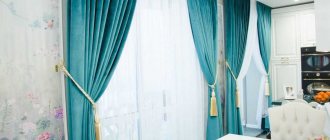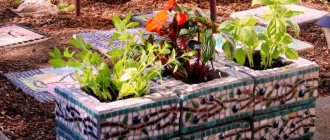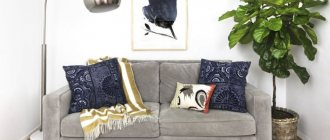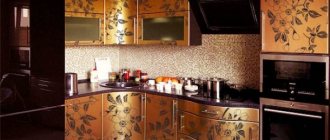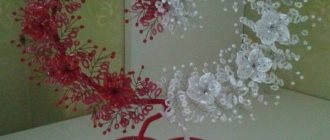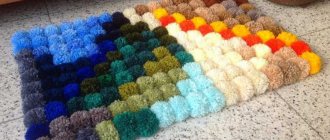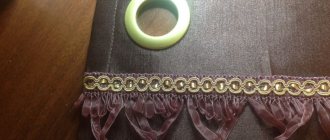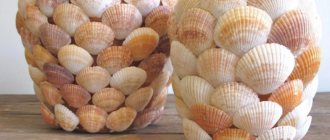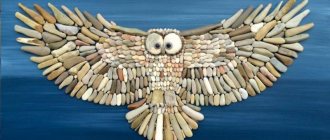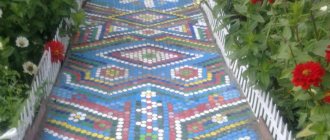Preparatory stage
In the question of how to sew a lambrequin with your own hands of a narrow sample, detailed instructions will help, you should immediately notice the fact that even a beginner can cope with the work.
First of all, a pattern is created, the algorithm of actions is simple, it looks like this:
- On a sheet of paper you need to draw a horizontal line, which will be fixed to the cornice and will serve as a guide.
- The width and footage of the swag are calculated.
- Then we move on to calculating the arc length.
- Attention is paid to the cascade; the visual design of the folds and their drapery will depend on this decision.
- Start cutting out the blanks.
With some types of fabric, you need to be as careful as possible at the preparation stage, because awkward movements will inevitably stretch the thin structure or cause damage.
How to perform sewing steps
You should follow the instructions:
Related article: DIY bed canopy: making a canopy
Pattern of a rigid lambrequin.
- Apply a special pattern prepared in advance to cut out the base of the bandeau.
- Iron the fabric with a warm iron.
- The fabric is glued onto the bandeau with a warm iron.
- Excess fabric from the edges is trimmed to 5 cm.
- Next, the fabric is placed on the lining.
- Using pins, pierce three sides without the top.
- Sew one centimeter from each edge of the bandeau.
- Next, the excess fabric is trimmed.
- After this, the product is straightened to the front side.
- The upper edge is turned right side out, pulled taut, and pinned with a pin.
- After this, you need to pin the Velcro on the hard side to the cornice.
- After this, the Velcro is fixed with machine stitching.
- Next, you need to trim the material exactly next to the adhesive tape.
- After this, the adhesive tape is unscrewed and pierced with a pin.
If this method of making a rigid lambrequin is too complicated, then the panel is made without a special lining, cutting off the fabric exactly where the edge of the adhesive base passes. Using a glue gun, reinforce the finishing material along all edges. The decoration can be cord, braid, fringe.
In the process of making a rigid lambrequin yourself, you should follow a few simple steps:
To sew a lambrequin you will need a roll of thick fabric.
- Make a regular pattern. First, for the template, exactly all the dimensions of the future gang lambrequin are taken. It is first necessary to determine exactly how the product will look, covering the entire cornice. The shape of the bandeau can be strict or have shapes and teeth.
- You will need to buy a frame, that is, a finished bandeau-pro product in a roll. This is a dense fabric, which is non-woven or dublerin, perhaps also a material for decoration.
- According to the pattern, it is necessary to cut out the frame, taking into account all seam allowances (5 - 6 cm on all sides).
- Prepared pieces of fabric need to be glued to the bandeau panel (you can use a steam generator, which is ideal for appliqués).
- The edges of the bandeau are treated with Velcro, which is glued at a distance of about 3 cm from the edge so that it is invisible.
- The decorated lambrequin should be placed on a special cornice where it was planned.
Tooling and stitching material
Among the basic accessories for creating a lambrequin with your own hands for beginners, it is worth highlighting:
- Sharp scissors.
- Centimeter tape for measurements.
- Enough paper to make a pattern.
- Chalk or small bar of soap for tailoring.
- Large square.
Once all the pieces are cut, you need to trim the edges with bias tape, otherwise the appearance will be ugly. The prepared table should be well lit; it is better to allocate as much free space as possible for the convenience of the process.
The components of the future masterpiece are laid out on the surface and the planned folds are highlighted. The formed elements must be “baited”; after control fitting, all blanks are sewn together and attached to the rail.
Common materials for work
Looking at numerous photos of self-made lambrequins, the question arises as to what raw materials are best used in the process.
The purchase of material should be approached seriously, because decorative elements should not lose their shape and become a decoration, and not cause surprise from the unsuccessful design of the home.
Flowing foundations such as:
- Veil.
- Semi-organza.
- Linen.
- Curtain fabrics.
For decorative work in the living room, experts advise using denser types of fabric; such additions much better emphasize the status of the owner. At the time of purchase, it will not be superfluous to pre-lay out the folds; this will help you avoid miscalculation in size.
When choosing a fabric with a pattern, you need to pay attention to the shade; it should be combined with the rest of the contents in the room.
Important! Professional tailors do not recommend purchasing ordinary organza for such decorative purposes. The material is very hard and it will not be possible to create smooth lines, which will certainly spoil the final appearance.
How to make a rigid lambrequin with your own hands
According to the method of sewing, lambrequins are divided into complex and simple.
To decorate the lambrequin you will need beads.
The first combine soft and hard types. These combinations are often made from softer materials. When selecting ready-made purchased products for pre-sewn curtains, you should pay special attention to the main color of the curtain material.
If you start learning how to sew hard-type lambrequins, then first it is better to make one for the kitchen. This will not require the invention of special patterns for a specific design. Decorating a window with a rigid type of lambrequin called a gang will be ideal for any room, from a nursery to a study.
The decoration of the products is fringe, cords or flowers from different fabrics. To make it yourself, you will need the following tools and materials:
- The finished bandeau base is 45 cm wide, you can use adhesive tape.
- Iron.
- Decorative finishing.
- Sewing machine.
- Scissors.
- The tape is sticky.
Using a veil
The raw materials are quite popular, which is why it is better to find out as much existing information as possible about such lambrequins for curtains with your own hands, long before starting work on the creation.
- The material is quite light and folds can be draped without any problems; it is important to correctly calculate the volume of the fabric; at this stage it is worth considering the type of curtain and how many sections it will contain.
- A simple type of product will require adding 15 to 20 cm to the length on each side. Elements with one section when created should have a value multiplied by 1.5 times.
- The pattern begins only after cutting the paper blanks, the dimensions must fully correspond to the natural size, taking into account all the small nuances it will be possible to create ideal proportions.
Openwork lambrequin bandeau
One of the design options for such a lambrequin could be openwork appliqué. For it you need to choose a fabric of a contrasting color in relation to the base. This way the openwork weaves will be better visible. The fabric for the base can have an unobtrusive pattern, but a plain base will look good.
It will also be interesting: Photos and videos of making Roman blinds from blinds with your own hands
You can draw the pattern for the openwork yourself, to suit your taste. Intertwining stems and leaves, an ornament on one of the interior details, or a vignette you like on a box of chocolates - everything will be appropriate if you do not overload the bandeau with decorative overlays. The openwork must first be made on paper in full size, and then cut out and transfer the pattern to the prepared fabric.
There are also no particular difficulties in how to prepare material for appliqués. You will need non-woven fabric and web to connect the layers of the openwork element. Iron the fabric for the front side with a dry iron to the adhesive part of the interlining. On its reverse side, lay out an adhesive web, and on top of it a lining of synthetic padding polyester, quilted with a thin fabric. The padding polyester should be inside the multi-layer cake.
To create clear, melted contours of the openwork, you need an electric burner. You can buy a tool in craft stores or borrow it from friends if you only need it for one time. Having redrawn the pattern on the wrong side of the glue cake, carefully cut it out with the heated tip of the burner. Place the openwork parts on the base of the lambrequin and attach with a hot glue gun. Add rhinestones and sparkles, hanging elements, etc.
Working with hard fabrics
The process is more complex; before you start making openwork lambrequins with your own hands, you should practice on light samples.
- But if you have the right pattern, there shouldn’t be any problems; thanks to such auxiliary materials, beginners can feel more confident. Do not forget about the allowance for tucking the fabric; it is left on both sides of the cornice when measuring; 10 cm will be quite enough for further manipulations.
- At the top, the base is created smooth, and the bottom is designed in one of the styles, which you will be able to familiarize yourself with while viewing master classes or photos of finished structures.
To transfer the pattern, fabric with an adhesive base is purchased, at this point allowances of 2-3 cm are left, then the two elements are fastened with pins or small needles to give strength.
Recommendation! When forming the base, fabric allowances are not needed; such manipulations are performed only with the outer fabric in order to make the appearance attractive by tucking.
Rigid figured lambrequin: how to sew correctly
It is necessary in advance to compare the size of the future product with the size of the room. Transfer all obtained measurement results to a wooden panel or dense material, marking the complex curly edges of the product and its sides. Next, you need to cut out a special lining and gasket of a similar shape and size, taking into account a seam allowance of 1.5 cm on the sides of the sample. To make a rigid lambrequin with curly edges, you should take:
- wooden plank;
- material for the sample and lining to cover them;
- rings for the cornice to sew onto the lambrequin;
- cord and braid;
- special glue for all types of fabric.
Sewing a rigid type lambrequin is possible if you follow the procedure for performing the following work:
Pattern patterns for various rigid lambrequins.They take the base material and cut out a lambrequin from it using a special template. Be sure to take into account the grain thread when cutting. After cutting the fabric, leave all seam allowances, which should be 3 cm. After this, cut the fabric for the sides of the lambrequin.
- The lining material is strengthened by placing a product cut according to a special template on it. In this case, it is important to observe the place where the middle of the material passes, combined with the middle of the future lambrequin. Be sure to adhere to all seam allowances on each edge, taking into account the rounded lines. The edge of the product is cut with scissors. From all edges where cuts are made, the material must be coated with glue. Each edge with cuts is wrapped to the level of the allowances and glued to the wrong side of the material, pressing with force with your hands. The lining fabric is processed in a similar way, gluing it to the back side of the lambrequin using an iron, and from each edge using special glue.
- Initially, the cut out part is strengthened onto the resulting rigid base with a lining and cuts are made again so that the edges of the product can be folded. Use pins to pin together the resulting parts, pulling the base material tighter. All prepared corners with cuts must be glued to the lining and base, ironing with a hot iron. When processing the edges of the sidewalls of the lambrequin, proceed in the same way.
- To properly attach the lining to a rigid base, it is laid face up. All edges must be finished with blind stitches. Only the top edge remains raw, that is, unstitched. The edge is finished using hidden stitches. The product is not processed at one end, since this end is the leading edge of the base. All sides of the future lambrequin must be processed.
- Next, the front panel of the lambrequin must be edged, and the length of its edges must be determined. For edging, a cord of a certain length is used, the ends of which are tucked under the base lining. The cord is sewn to each edge using hidden stitches. The untreated part of the gasket is stitched by sewing a special cord to the panel.
- To correctly frame the sides of the lambrequin, you should determine the length of the edge running along the side parts, along with the top cut, that is, the back and bottom. After this, measure and cut the appropriate length of cord, sewing it to each edge, leaving the fourth free. All holes are closed, and the ends are tucked inward. After this, the lining is sewn on at each edge.
- Rings are used to attach the lambrequin to the cornice. First take small screws to secure the product to the bar at the top. The rings should be sewn to the back of the lambrequin. It is necessary to take into account the equal distance that should be between the screws and the rings. Before attaching the panel, the rings should be placed on the cornice strip.
The finished product can be strengthened when the ceiling surface is flat. The tape on the sticky side is glued to the cornice from its outer surface, and the other edge of the tape should be sewn on the wrong side of the lambrequin.
If you do not need to hide the cornice under the finished lambrequin because it is quite attractive, then 1/2 of the adhesive strip should be glued to the back of the baguette. And the other half of the Velcro tape is sewn onto the front side of the lambrequin.
Final stage
To ensure that the fabric sticks to the base as reliably as possible, use an iron heated to a certain temperature and iron the surface with it.
Using step-by-step instructions, you can avoid a lot of awkward situations; such manuals should be studied in advance, and the diagrams should be placed in front of you while working.
It is necessary to cut out the lining material according to the sample, all layers of the decorative element are assembled into one masterpiece, and stitched on a sewing machine.
It is important to remember that specimens with a rounded shape must have notches, otherwise the canvas will begin to form unplanned folds. This technique is performed from the inside of the device, which performs a decorative function.
Types of lambrequins. Advantages of hard
There are several options for this decorative element of curtains:
- simple;
- hard;
- soft;
- combined.
The first is a strip of fabric gathered into folds on a curtain tape or by hand. A rigid lambrequin has a fabric front side and a dense non-woven back or inner part.
The soft one consists of a certain number of alternating sequentially complex elements with folds - swags, de jabot, molds. Combined is a combination of the two previous options.
The advantage of a rigid lambrequin is that with a fairly simple sewing technology, a very beautiful, effective decorative product is obtained. This effect is achieved thanks to the ability to make a complex curly bottom that will be fixed.
Photos of homemade lambrequins
3333333
